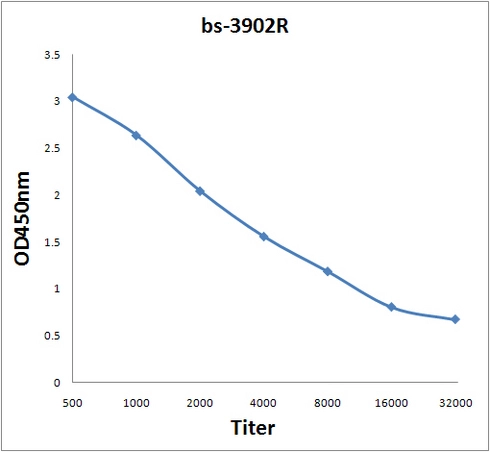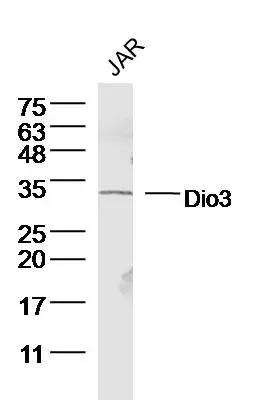
ELISA analysis of 2microg GTX60156 anitgen in 100microl buffer using serial diluted GTX60156 DIO3 antibody.
DIO3 antibody
GTX60156
ApplicationsWestern Blot, ELISA
Product group Antibodies
ReactivityHuman, Sheep
TargetDIO3
Overview
- SupplierGeneTex
- Product NameDIO3 antibody
- Delivery Days Customer9
- Application Supplier NoteWB: 1:300-1000. *Optimal dilutions/concentrations should be determined by the researcher.Not tested in other applications.
- ApplicationsWestern Blot, ELISA
- CertificationResearch Use Only
- ClonalityPolyclonal
- Concentration1 mg/ml
- ConjugateUnconjugated
- Gene ID1735
- Target nameDIO3
- Target descriptioniodothyronine deiodinase 3
- Target synonyms5DIII; D3; deiodinase, iodothyronine type III; DIOIII; iodothyronine deiodinase, placental type; selenoprotein DIO3; thyroxine 5-deiodinase; thyroxine deiodinase type III (selenoprotein); TXDI3; type 3 DI; type 3 iodothyronine selenodeiodinase; type-III 5' deiodinase
- HostRabbit
- IsotypeIgG
- Protein IDP55073
- Protein NameThyroxine 5-deiodinase
- Scientific DescriptionThe protein encoded by this intronless gene belongs to the iodothyronine deiodinase family. It catalyzes the inactivation of thyroid hormone by inner ring deiodination of the prohormone thyroxine (T4) and the bioactive hormone 3,3,5-triiodothyronine (T3) to inactive metabolites, 3,3,5-triiodothyronine (RT3) and 3,3-diiodothyronine (T2), respectively. This enzyme is highly expressed in pregnant uterus, placenta, fetal and neonatal tissues, and thought to prevent premature exposure of developing fetal tissues to adult levels of thyroid hormones. It regulates circulating fetal thyroid hormone concentrations, and thus plays a critical role in mammalian development. Knockout mice lacking this gene exhibit abnormalities related to development and reproduction, and increased activity of this enzyme in infants with hemangiomas causes severe hypothyroidism. This protein is a selenoprotein, containing the rare selenocysteine (Sec) amino acid at its active site. Sec is encoded by the UGA codon, which normally signals translation termination. The 3 UTRs of selenoprotein mRNAs contain a conserved stem-loop structure, designated the Sec insertion sequence (SECIS) element, that is necessary for the recognition of UGA as a Sec codon rather than as a stop signal. [provided by RefSeq, May 2016]
- ReactivityHuman, Sheep
- Storage Instruction-20°C or -80°C,2°C to 8°C
- UNSPSC12352203
References
- Maternal nutrient restriction alters thyroid hormone dynamics in placentae of sheep having small for gestational age fetuses. Steinhauser CB et al., 2021 Oct, Domest Anim EndocrinolRead more

